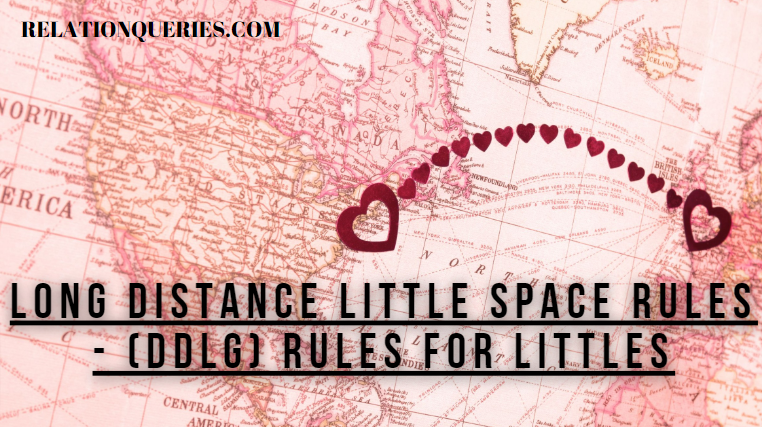
Long Distance Little Space Rules – DDLG Rules For Littles:- Long distance relationships can be challenging, but when you add the dynamic of being in a caregiver/little relationship, it can require even more effort and understanding.
In this article, we will explore the rules and strategies for making long-distance relationships work when you are in a caregiver/little dynamic.
Whether you are new to this type of relationship or have been in one for a while, these tips will help you navigate the challenges and maintain a strong connection with your little one.
What Are Littles?
This is a sexual relationship where the dominant male is the daddy figure and a woman plays the role of a young girl.
Littles are individuals who enjoy regressing to a childlike state in certain aspects of their lives.
This can include engaging in activities such as coloring, watching cartoons, or being cared for by a caregiver.
In a long-distance relationship, it can be difficult to provide the same level of care and support as in-person, but with the right approach, it is still possible to nurture the caregiver/little bond.
Creative Ways To Stay Connected
Even though you may be physically apart, there are numerous creative ways to stay connected with your little. Here are some ideas to help you maintain a sense of closeness:
- Virtual Dates and Activities: Plan virtual dates where you can engage in activities together, such as watching a movie simultaneously or having a virtual picnic. Use video calls to connect visually and share experiences.
- Surprising Each Other: Surprise your little one with small gifts or care packages sent by mail. These thoughtful gestures can make them feel loved and cherished in the distance. Consider sending them their favorite stuffed animal or a handwritten letter filled with encouragement and affection.
- Emotional Support: Long distance can be emotionally challenging, so it’s crucial to provide ongoing emotional support to your little. Be attentive to their needs and feelings, and offer a listening ear and comforting words whenever they need it. Use text messages or voice calls to offer reassurance and remind them that you are there for them.
- Managing Time Zones: If you and your little are in different time zones, it’s essential to find a balance that works for both of you. Consider creating a shared calendar to keep track of each other’s schedules and find overlapping time slots for quality conversations. Being mindful of time zone differences shows your commitment to making the relationship work despite the physical distance.
- Planning Visits: Whenever possible, plan visits to spend quality time together in person. Coordinate your schedules and plan ahead to make the most of the time you have together. Whether it’s a weekend getaway or an extended visit, these moments of physical closeness can strengthen your bond and create cherished memories.
- Dealing with Frustrations: It’s natural for frustrations to arise in any relationship, and long-distance caregiver/little dynamics are no exception. When conflicts or disagreements occur, approach them with patience, empathy, and a willingness to understand each other’s perspectives. Practice effective communication and find compromises that work for both parties to maintain a healthy and harmonious relationship.
- Maintaining Independence: While being a caregiver involves nurturing and taking care of your little one, it’s also crucial to maintain your own independence and personal growth. Encourage your little to pursue their own interests and hobbies, and make time for your own self-care and development. Balancing independence with the caregiver/little dynamic allows both partners to thrive individually and contribute positively to the relationship.
Understanding Long Distance Relationships
Long-distance relationships occur when two people are physically separated and cannot be together regularly. This can be due to various reasons, such as work, education, or personal circumstances.
In a caregiver/little relationship, the distance adds an extra layer of complexity, as the caregiver’s role often involves providing emotional support and nurturing the little’s childlike needs.
Challenges In Long Distance Littles Relationships
Being in a long-distance caregiver/little relationship presents unique challenges. Some of the common challenges include limited physical interaction, difficulty in expressing emotions, and the absence of immediate comfort and reassurance.
However, by understanding these challenges, you can find ways to overcome them and strengthen your bond.
Why Do I Attract Guys With Mommy Issues?
13 Long Distance Little Space Rules
Long distance relationships can pose challenges, especially for littles who require a nurturing and supportive environment known as “little space.”
Now we will explore effective rules and strategies for maintaining little space in a long-distance caregiver/little dynamic.
These guidelines will help you create a sense of security, playfulness, and comfort despite the physical distance.
#1. Understanding Little Space
Little space is a state in which individuals who identify as littles embrace their childlike side. It involves engaging in activities that provide a sense of comfort, innocence, and playfulness.
Littles may enjoy activities such as coloring, watching cartoons, or being cared for by a caregiver. Creating and maintaining little space is crucial for littles’ well-being and emotional fulfillment.
#2. Maintaining Little Space In A Long-Distance Relationship
Despite the challenges of distance, it is possible to maintain little space in a long-distance caregiver/little relationship.
By establishing clear rules, maintaining open communication, and incorporating virtual activities, you can cultivate a nurturing environment that supports the little’s needs.
#3. Establishing Clear Rules And Boundaries
Establishing clear rules and boundaries is essential for maintaining little space in a long-distance relationship.
Both the caregiver and the little should discuss and agree upon specific guidelines that align with the little’s preferences and comfort levels.
These rules may include designated little space times, appropriate modes of communication, and expectations for behavior during little space.
#4. Communication Is Key
Communication plays a vital role in any relationship, including a long-distance caregiver/little dynamic.
Regular and honest communication helps ensure both partners are on the same page regarding little space needs, desires, and boundaries.
It allows the caregiver to provide the necessary support, encouragement, and reassurance for the little one, even from a distance.
#5. Creating A Little Space Routine
Establishing a little space routine can help maintain a sense of structure and consistency despite the physical separation.
Collaborate with your little one to create a schedule that includes designated little spacetimes.
During these times, engage in activities that evoke their desired little space, such as reading bedtime stories, having virtual tea parties, or engaging in imaginative play.
#6. Virtual Little Space Activities
In a long distance caregiver/little relationship, virtual activities are invaluable for creating and maintaining little space.
Explore virtual platforms that offer interactive games, coloring apps, or virtual scavenger hunts.
Engaging in these activities together can provide a sense of shared experience and connection, helping the little ones feel immersed in their desired little space.
#7. Caregiver’s Role In Supporting Little Space
As a caregiver, it’s essential to understand and support the little’s need for little space. Show enthusiasm and engage actively during designated little spacetimes.
Offer words of affirmation, provide gentle guidance, and create a safe space where the little feels comfortable expressing their child-like side.
Pay attention to their cues and actively participate in activities that promote their sense of playfulness and innocence. By nurturing their little space, you strengthen the caregiver/little bond despite the physical distance.
#8. Self-Care For Littles
Self-care is crucial for little, even in a long distance relationship. Encourage your little ones to engage in self-soothing activities that bring them comfort and joy.
This can include cuddling with a stuffed animal, listening to calming music, or practicing mindfulness exercises.
Remind them to prioritize their emotional well-being and engage in activities that promote self-nurturing.
#9. Dealing With Frustrations And Challenges
Long-distance relationships can be challenging, and frustrations may arise. It’s important to address these challenges openly and find constructive ways to navigate them.
Encourage open communication and active listening to understand each other’s feelings and perspectives. Work together as a team to find solutions and provide support during difficult times.
#10. Trust And Reassurance
Building trust is essential in a long distance caregiver/little relationship.
Both partners should actively work on building trust by being reliable, consistent, and transparent.
Reassure you’re little of your commitment and remind them of your presence, even when physically apart.
Trust forms the foundation for a healthy and secure caregiver/little dynamic.
#11. Planning Visits And Physical Little Space
Whenever possible, plan visits to spend physical time together and engage in little space activities.
These visits provide an opportunity to create cherished memories and deepen the bond between the caregiver and the little one.
Coordinate schedules, plan activities that align with their little space preferences, and make the most of the time you have together.
#12. Adapting To Change
Flexibility and adaptability are key when it comes to maintaining little space in a long distance relationship. Recognize that circumstances may change, and both partners need to adapt to new situations.
Embrace the opportunity to find creative solutions and explore alternative ways of nurturing little space, even if they differ from the usual routine.
#13. Patience And Understanding
Long distance relationships require patience and understanding. Recognize that there may be limitations in providing physical proximity and immediate support.
Practice empathy, actively listen to your little one’s needs, and validate their feelings.
Understand that maintaining little space in a long distance relationship requires extra effort and commitment from both partners.
What is a little and a little space?
Conclusion
Maintaining little space in a long distance caregiver/little relationship is possible with clear rules, effective communication, and creativity.
Embrace virtual activities, establish routines, and prioritize the emotional well-being of your little ones.
By nurturing their little space and providing consistent support, you can create a sense of security, playfulness, and connection, bridging the physical gap that separates you.
FAQs
Yes, it can work with open communication, trust-building, and creative ways to stay connected.
Regular communication is essential. Aim for daily check-ins through texts, calls, or video chats.
Surprise them with small gifts, offer emotional support, and actively listen to their needs and feelings.
Address frustrations openly, practice active listening, and work together to find constructive solutions.
Yes, with clear rules, communication, and virtual activities, little space can be maintained despite the distance.



